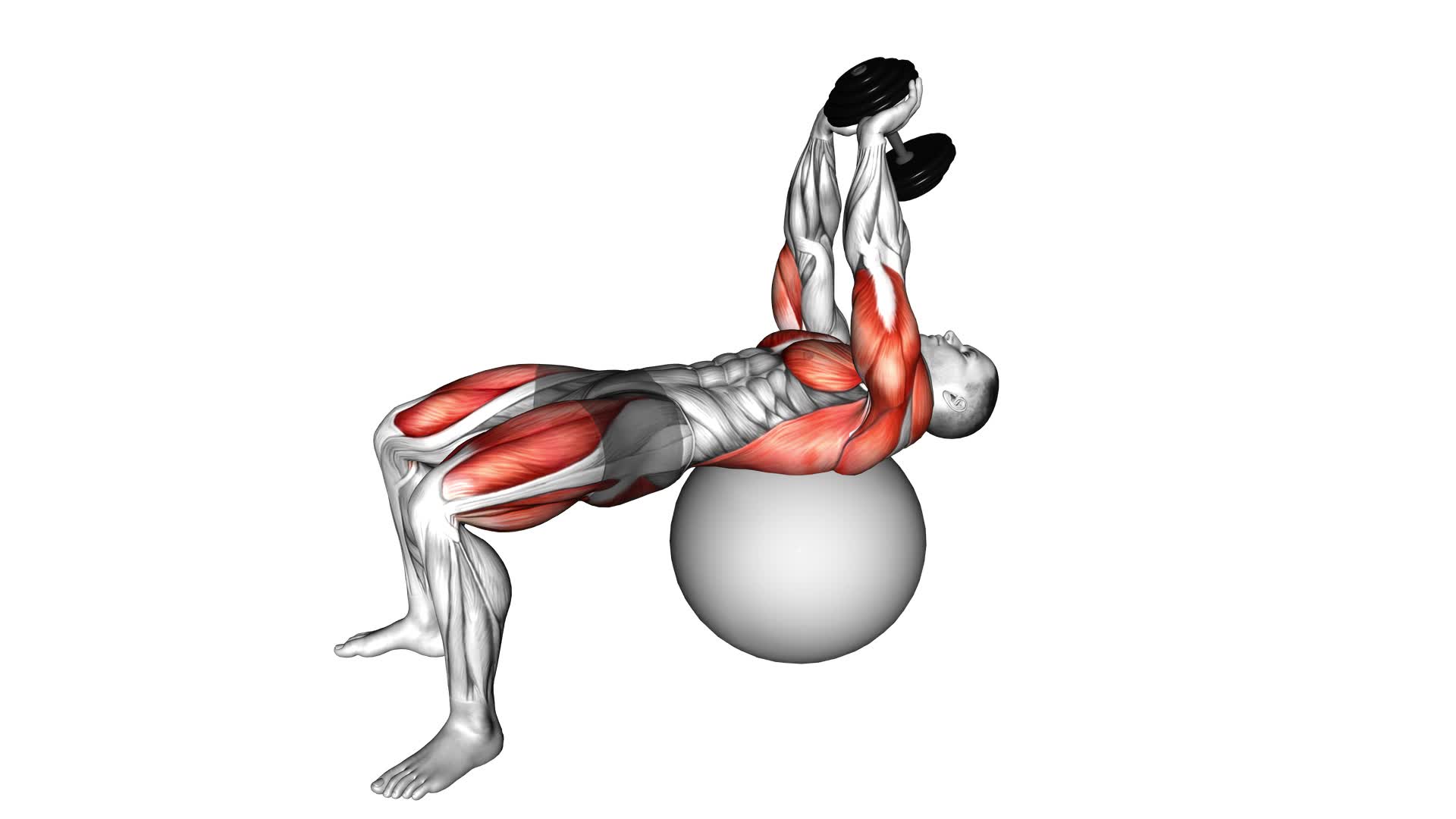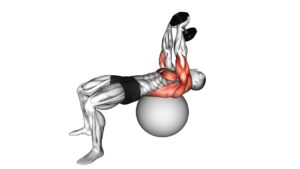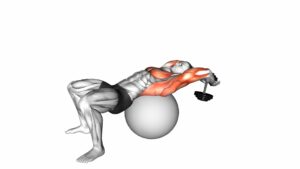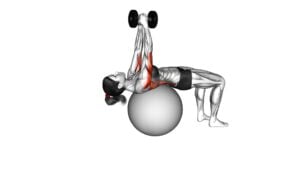Dumbbell Pullover Hip Extension on Exercise Ball – Video Exercise Guide & Tips

Are you looking for a challenging exercise that targets your core and glutes? Look no further than the dumbbell pullover hip extension on an exercise ball.
Watch This Exercise Video
This exercise not only strengthens your muscles, but also improves your stability and balance. With just a few simple steps, you can perform this exercise and start reaping the benefits.
Get ready to sculpt and tone your body with this effective workout. Let's dive into the details and learn how to do it correctly.
Key Takeaways
- Strengthens core and glutes
- Targets lower body muscles (glutes, hamstrings, quadriceps)
- Improves overall lower body strength and stability
- Alleviates back pain and improves posture
Benefits of the Dumbbell Pullover Hip Extension
One benefit of the Dumbbell Pullover Hip Extension is that it helps you strengthen your core and glutes. This exercise specifically targets the muscles in your lower body, including your glutes, hamstrings, and quadriceps. By performing this exercise regularly, you can improve your overall lower body strength and stability.
Another benefit of the Dumbbell Pullover Hip Extension is that it helps to improve your posture and spinal alignment. As you extend your hips and lift your glutes off the ground, you engage your core muscles, which play a crucial role in maintaining proper alignment of your spine. This can help alleviate back pain and improve your overall posture.
Additionally, this exercise can also enhance your flexibility and range of motion. The movement involved in the Dumbbell Pullover Hip Extension requires a good amount of hip mobility, which can help to increase your overall flexibility. By regularly performing this exercise, you can improve your range of motion in your hips and lower back.
Equipment Needed for the Exercise
To perform the Dumbbell Pullover Hip Extension, you'll need a few pieces of equipment.
The first item you'll need is an exercise ball. The exercise ball is a large inflatable ball that's used to support your body during the exercise. It helps to engage your core muscles and adds an element of instability, making the exercise more challenging. Make sure to choose a ball that's the right size for your height.
In addition to the exercise ball, you'll also need a pair of dumbbells. The dumbbells are used to add resistance to the exercise and target your upper body muscles. Choose a weight that's challenging but allows you to maintain proper form throughout the exercise.
When selecting dumbbells, it's important to consider your fitness level and goals. Beginners may start with lighter weights, while more advanced individuals may opt for heavier weights. It's always a good idea to consult with a fitness professional to determine the appropriate weight for your specific needs.
Proper Form and Technique
To perform the Dumbbell Pullover Hip Extension with proper form and technique, maintain a stable position on the exercise ball while gripping the dumbbells tightly. Here are some tips to ensure you execute this exercise correctly:
- Maintain stability on the exercise ball: Sit on the exercise ball and position yourself so that your feet are firmly planted on the ground. This will help you maintain balance and stability throughout the exercise.
- Grip the dumbbells tightly: Hold the dumbbells firmly in your hands, ensuring a tight grip. This will help you maintain control and stability during the movement.
- Avoid arching your back: One common mistake is to arch your back excessively during the exercise. To prevent this, engage your core muscles and keep your back in a neutral position throughout the movement.
- Extend your hips fully: It's important to fully extend your hips at the top of the movement to engage your glutes and hamstrings effectively. This will maximize the benefits of the exercise.
- Avoid using momentum: Another common mistake is using momentum to complete the exercise. Focus on controlled and deliberate movements, using your muscles to perform the exercise rather than relying on momentum.
Variations and Modifications
To add variety to your workout routine, you can explore different variations and modifications of the Dumbbell Pullover Hip Extension exercise. These alternatives won't only keep your workouts interesting but also target different muscle groups for a well-rounded fitness regimen.
One alternative exercise you can try is the Single-Leg Dumbbell Pullover Hip Extension. Instead of using both legs, you'll perform the exercise with one leg at a time. This variation challenges your balance and stability while still engaging your core and glutes.
Another modification is the Dumbbell Pullover with Stability Ball. Instead of using an exercise ball for the hip extension, you'll place your upper back and shoulders on the stability ball. This variation adds an element of instability, forcing your core muscles to work harder to maintain balance.
Now, let's talk about common mistakes to avoid during the Dumbbell Pullover Hip Extension exercise. One mistake is arching your lower back excessively, which can strain your spine. To prevent this, engage your core muscles and maintain a neutral spine throughout the movement.
Another mistake is rushing through the exercise and using momentum instead of controlled movements. Remember to perform the exercise slowly and focus on squeezing your glutes at the top of the movement.
Tips for Maximizing Your Results
For optimal results, make sure to focus on proper form and engage your muscles throughout the Dumbbell Pullover Hip Extension exercise. Here are some tips to help you maximize your results:
- Common Mistakes:
- Avoid using too much momentum: It's important to control the movement and not rely on swinging your body.
- Don't arch your back excessively: Keep your core engaged and maintain a neutral spine position to protect your lower back.
Recommended Sets and Reps for Beginners:
- Start with 2-3 sets of 8-10 reps: This will allow you to build strength and endurance gradually.
- Focus on quality over quantity: Make sure to perform each rep with proper form and engage the targeted muscles fully.
By following these tips, you can ensure that you're getting the most out of your Dumbbell Pullover Hip Extension exercise.
Remember to start with a weight that challenges you but allows you to maintain good form. As you become more comfortable and stronger, gradually increase the weight and intensity.
Consistency is key, so aim to incorporate this exercise into your routine at least 2-3 times per week. With time and dedication, you'll start to see improvements in your strength, stability, and overall fitness level.
Frequently Asked Questions
How Many Sets and Reps Should I Do for the Dumbbell Pullover Hip Extension Exercise?
To optimize your workout with the dumbbell pullover hip extension exercise, it's crucial to determine the appropriate sets and reps. By focusing on the Current Question, you'll gain valuable insights into the variations and benefits of this exercise.
Understanding the recommended sets and reps will help you achieve maximum results, allowing you to effectively target your core and hip muscles.
Can I Do the Dumbbell Pullover Hip Extension Exercise if I Have Lower Back Pain?
If you have lower back pain, it's important to be cautious when doing the dumbbell pullover hip extension exercise. Lower back pain can be aggravated by this exercise, so it may be best to avoid it.
Instead, consider some dumbbell pullover alternatives that are easier on the back. Remember, the benefits of the dumbbell pullover can still be achieved through other exercises that target the same muscle groups without putting strain on your lower back.
Is It Necessary to Use an Exercise Ball for the Dumbbell Pullover Hip Extension Exercise?
Using an exercise ball for the dumbbell pullover hip extension exercise has its pros and cons.
On the positive side, the exercise ball provides an unstable surface, engaging your core muscles for added stability. It also allows for a greater range of motion, targeting your hip muscles more effectively.
However, it may require more balance and coordination.
If you prefer a more stable base, you can perform variations of the dumbbell pullover hip extension exercise without the exercise ball.
Can I Use a Barbell Instead of Dumbbells for the Pullover Hip Extension Exercise?
Yes, you can definitely use a barbell instead of dumbbells for the pullover hip extension exercise. Using a barbell can provide a different level of challenge and engagement for your muscles.
It's a great alternative if you don't have access to dumbbells or if you want to switch up your routine. Just make sure to use proper form and start with a weight that you can handle comfortably to avoid injury.
Can I Perform the Dumbbell Pullover Hip Extension Exercise if I Have a Knee Injury?
If you have a knee injury, it's important to be cautious when performing the dumbbell pullover hip extension exercise. Before attempting this exercise, consult with a healthcare professional or physical therapist. They can provide modifications that will allow you to still work on your hip extension without putting unnecessary strain on your injured knee.
Additionally, there are alternative exercises that can target the same muscle groups without aggravating your knee injury.
Conclusion
In conclusion, the dumbbell pullover hip extension is a highly effective exercise that targets the hip muscles and enhances overall strength and stability.
By following the proper form and technique, using the appropriate equipment, and incorporating variations and modifications, you can maximize your results.
Remember to always consult with a fitness professional or trainer before attempting new exercises to ensure safety and proper execution.
Keep challenging yourself and enjoy the benefits of this great exercise!

Author
Years ago, the spark of my life’s passion ignited in my mind the moment I stepped into the local gym for the first time. The inaugural bead of perspiration, the initial endeavor, the very first surge of endorphins, and a sense of pride that washed over me post-workout marked the beginning of my deep-seated interest in strength sports, fitness, and sports nutrition. This very curiosity blossomed rapidly into a profound fascination, propelling me to earn a Master’s degree in Physical Education from the Academy of Physical Education in Krakow, followed by a Sports Manager diploma from the Jagiellonian University. My journey of growth led me to gain more specialized qualifications, such as being a certified personal trainer with a focus on sports dietetics, a lifeguard, and an instructor for wellness and corrective gymnastics. Theoretical knowledge paired seamlessly with practical experience, reinforcing my belief that the transformation of individuals under my guidance was also a reflection of my personal growth. This belief holds true even today. Each day, I strive to push the boundaries and explore new realms. These realms gently elevate me to greater heights. The unique combination of passion for my field and the continuous quest for growth fuels my drive to break new ground.



